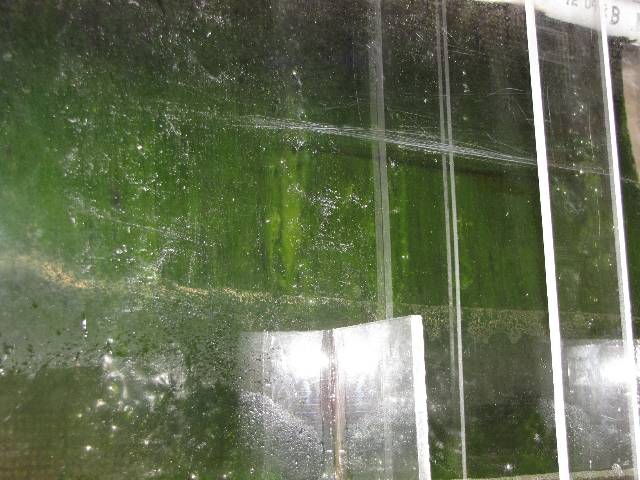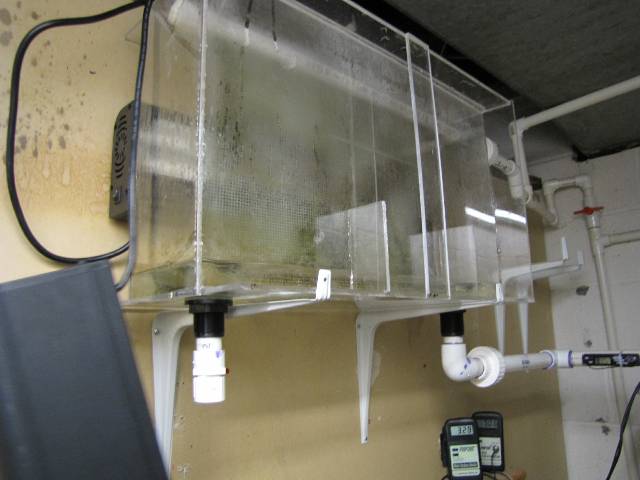Glad it survived. Once it fills in the bald spot should go away.
Glad it survived. Once it fills in the bald spot should go away.
Filling in nicely. Survived another power outage. I'm doing a couple of small updates this weekend, a new lid and then change the drain tube from 3/4 to 1/1 inch. Will get to see how easy it is to clean in another week or two.

Nice!!
Decided to clean the mesh during a slight upgrade yesterday. Cleaning the mesh was a breeze. I had to place a cross beam on the lid to prevet warping and put in a one inch drain to handle the entire flow of the system. I am happy with the new scrubber. Had I known, I would have replaced the old MMFI years ago.

Let's see if you can hold it out at arms length in a few months time, when it's really going !!
the plants are unaffected? that is with proper ferts i guess
It appears that there is some question as to why an algae scrubber would be used in a freshwater planted aquarium. This is a difficult question to explain for two reasons. The first reason is that the explanation is really complicated and covers a lot of ground. The second reason is that some well accepted preconceptions are false. I am going to address these issues here, in a series of posts, moderators willing. Comments, questions and disagreements are welcome. Let’s see what happens.
Some of the false preconceptions are:
1) Fish help plants. False. In an aquarium, fish are detrimental to plants. They do not add enough CO2 to be measurable or affect the plants, and they do add waste products that are not needed by and are detrimental to the plants. Their food and waste contribute to algae growth without helping the plants, and these wastes tend to cause the substrate to deteriorate and go anaerobic. Aquarium plants need very little of the big three macros, NPK, and more than enough of them is provided by any water supply commonly found in the USA.
2) Airstones and fountains help tanks and ponds. Mostly false. They are of use to oxygenate water and provide circulation, but that’s it. When water comes from sources like rain, ground, streams, and even muni supplies it will contain either CO2 or SO2 in significant concentrations. These gases, particularly CO2, are easily dissolved and expelled. They occur naturally as the byproducts of bacterial action, aerobic or anaerobic. Take a glass of any freshly drawn water and measure its pH. After sitting open for 24 hours the pH raises a point or more from the CO2 gassing out. CO2 dissolves very easily in water, but it gasses out just as easily. Adding airstones or fountains to ponds and aquariums is only of use in fish tanks as it kills plants which ultimately do a much better job of oxygenating the water. Any disturbance of the water causes the CO2 to gas out, the bigger the disturbance the larger the gassing out. A typical airstone will purge all of the CO2 from an aquarium in 24 hours. Why doesn’t an airstone add CO2 from the atmosphere? 78.09% nitrogen, 20.95% oxygen, 0.93% argon, 0.039% carbon dioxide, that’s why! The amount added from the atmosphere is too small to measure.
3) An algae scrubber hurts plants. False. Discussed later.
Now let’s take a closer look at water. Anywhere in the USA the water, either municipal or from the ground or streams contains elevated levels of Nitrogen. This is a direct result of people, their wastes, their pets, their farms and their lawns. You can’t get away from it. Depending upon the source, there will also be salts, calcium and magnesium carbonates, iron, copper and other trace elements. Most of these compounds and elements are in too great a concentration for an aquarium. And most often, other trace elements like chelated iron, other metals and boron are in too low a concentration. In any case, needed trace elements will be quickly depleted and toxic trace elements will quickly accumulate in a closed system like an aquarium.
TBC
Nice info, when's the next instalment ?
Looking forward to the rest.
One correction though, if CO2 gasses out of water, the pH would rise, not fall.
I think what you mean here is CO2 does not dissolve easily, which is the reason it's hard to get CO2 into the water.CO2 dissolves very easily in water, but it gasses out just as easily
There are currently 1 users browsing this thread. (0 members and 1 guests)